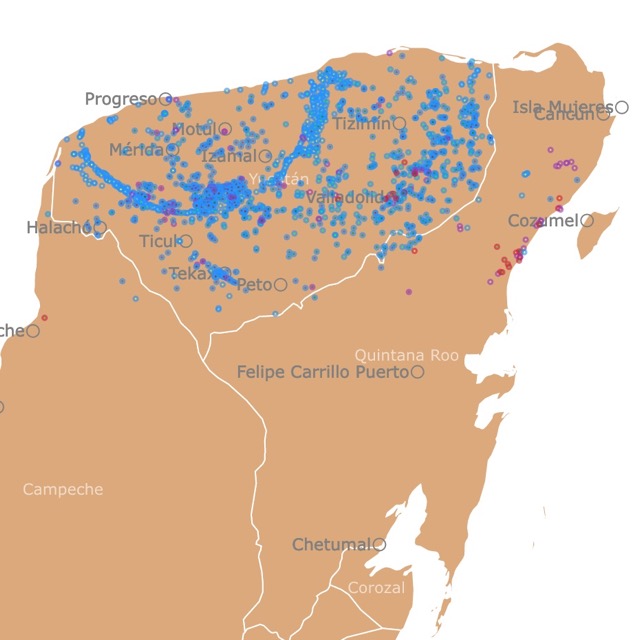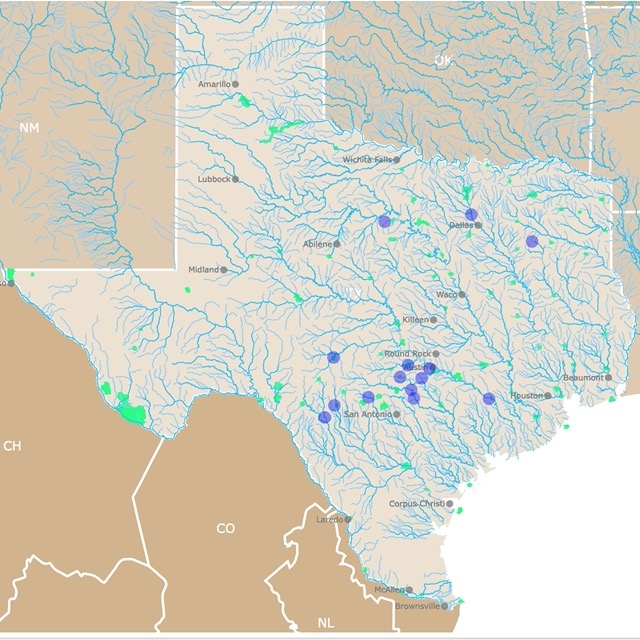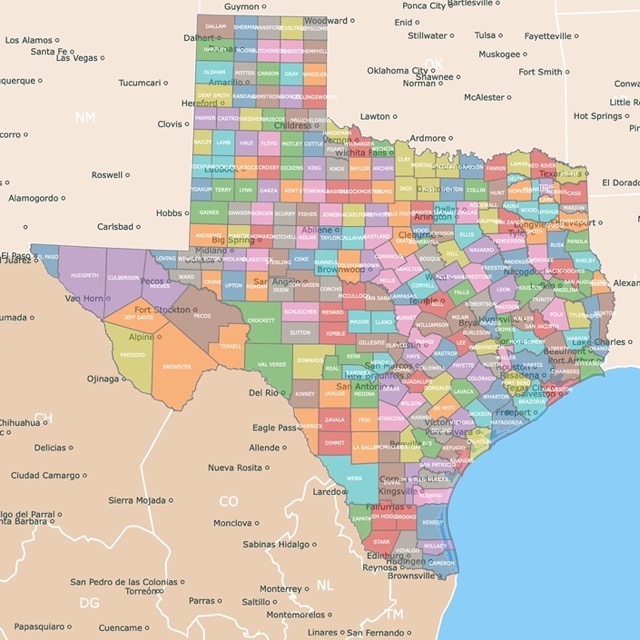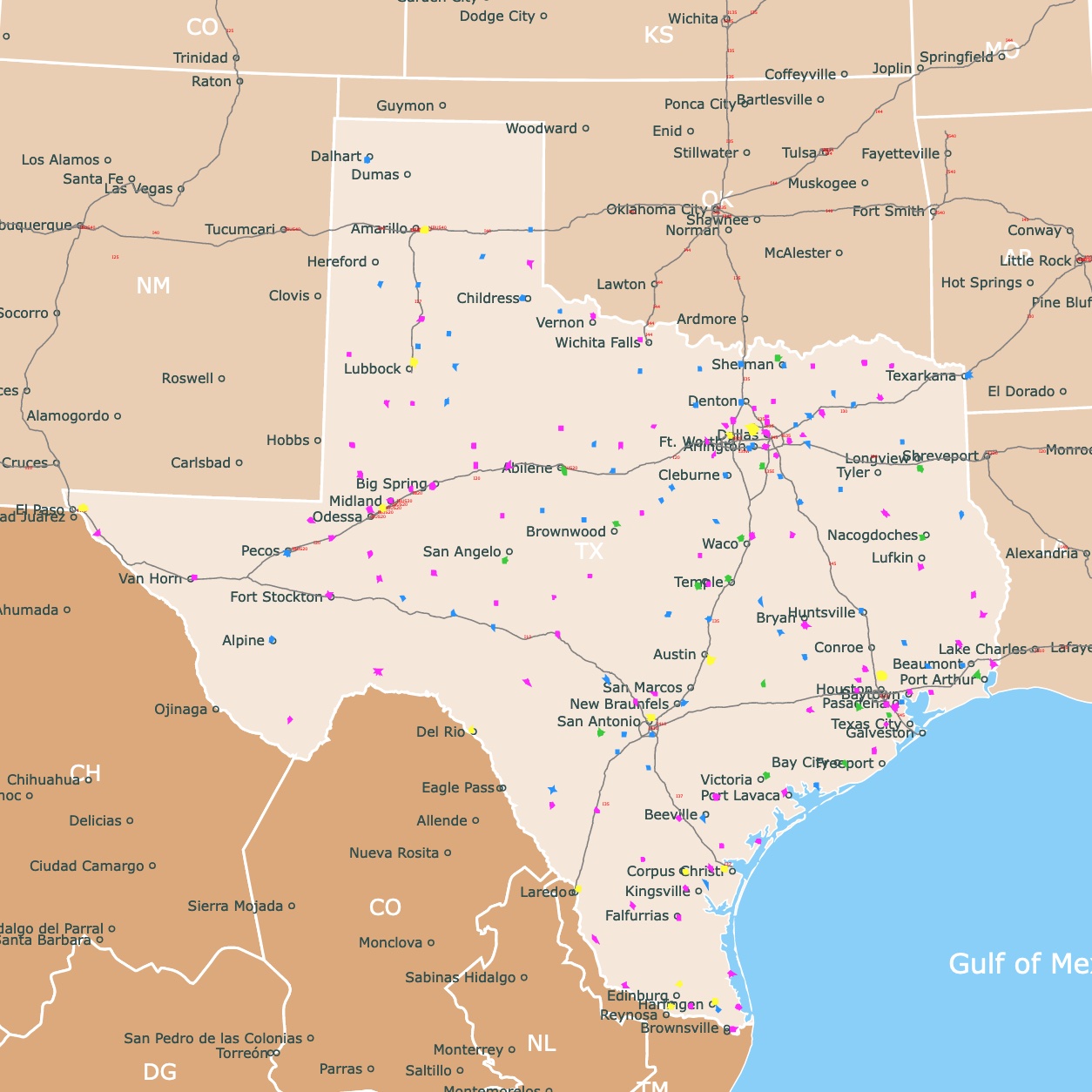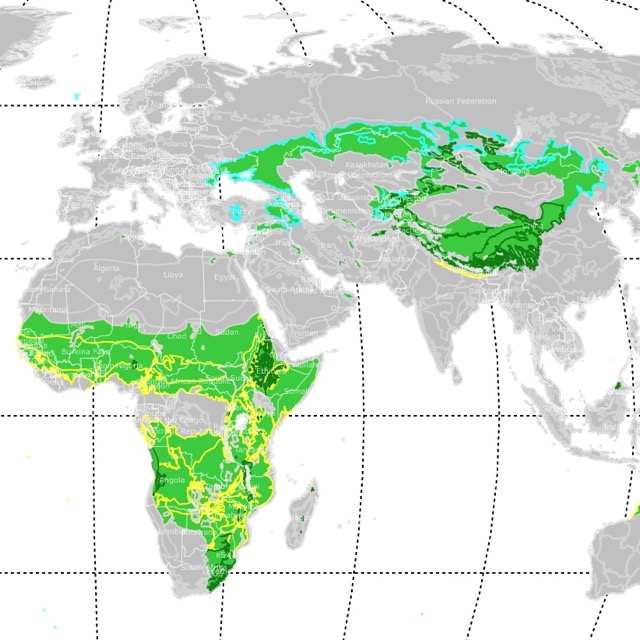Map of Texas Springs
This interactive map shows the Locations and Names of major springs in Texas. It also shows Wildlife Management Areas and Natural Parks. For more detail zoom in. For more information hover over the map, or scroll down.
| Key | |||||
|---|---|---|---|---|---|
| City | Spring | Spring Described | |||
| Park | Wildlife Management Area |
Texas | |||
Springs of Texas
Caves and caverns underground may behave as reservoirs of rainwater that seep through soil and rock. These places are called aquifers. Some aquifers may give rise to springs.
Water can emerge from one or multiple openings. The places where groundwater emerges through seeps and cracks form springs.
"Springs are naturally occurring features that convey excess groundwater to the land surface; they represent a transition from groundwater to surface water." USGS.

Springs are classified according to their average discharge. Large or First Magnitude springs may have around 100ft3/s average water discharge.
Springs are vital because they are home to invertebrates, fish, and amphibians.
They are also important because they are the headwaters of many rivers.
Springs are important sites of recreation and may have historical and cultural significance.
Many springs in Texas are a source of municipal or industrial water.
It is known that Texas has more than 3000 springs. No one knows the actual number because 95% of Texas land is private. This map has 1,891 springs displayed.
Some sites may have more than one spring. Others are known as swimming holes or creeks but not are not springs necessarily.
Before searching for any springs, remember that most are on private property. Visitors need permission before getting access.
Facts About Texas' Springs
- Comal Springs are the largest springs west of the Mississippi River.
- San Antonio is the largest city U.S. city, depending on Spring Water.
- San Solomon Spring in West Texas has the world's largest artificial, spring-fed swimming pool. It is located in Balmorhea State Park.
- Jacob's Well is one of Texas's most extensive underwater cave systems.
- Many cities were built near springs that provided water. For example, Salado, Salado Springs; Austin, Barton Springs; San Marcos, San Marcos springs; Comal Springs, New Braunfels, San Antonio, San Antonio and San Pedro springs, Uvalde, Leona Springs; Fort Clark, Las Moras Springs; and Del Rio, close to San Felipe Springs.
- Barton springs salamander and Austin Blind Salamander only live in Barton springs.
- San Marcos spring has the Texas wild rice, and Texas Gambusia fish is found only in San Marcos. Source: Texas Aquatic Science.
10 Must-See Springs in Texas
Given the Texas geography, it is common for locals and visitors to go to different springs and swimming holes during the summer months.
Here is a description of the most beautiful springs in Texas.
San Solomon Spring
San Solomon Spring is located in Balmorhea State Park. Situated in an arid landscape, it is an oasis of green and blue in a dry land.

This is the world's largest spring-fed swimming pool, with 1.75-acres (0.71 ha).
The largest spring produces up to 20 million gallons (90,850 cubic meters)of water daily. The waters are about 74°F (23°C)!
The central portion of the swimming hole is about 25 ft (7.6 m).
In the 1930s, the pool was constructed by just making the surrounding walls, as well as cemented canals to irrigate local farming fields. The bottom is still natural.
Since the pool was built in the 1930s, it has been a historical site. No major changes can be made to it.
Because the spring is in a desert, it is a magnet for mammals, fish, and migrating birds. Some fish include the Comanche Springs pupfish and the Pecos gambusia, both endangered and unique to the area.
The deep pool with crystal clear waters and aquatic life attracts divers from around Texas. Source: Texas Parks and Wildlife.
The pool is open year-round and requires a reservation.
Barton Springs
Barton Springs is located in Zilker Park, within the city of Austin, TX. The park has a total of 358 acres of natural surroundings for visitors and swimmers. The pool exists within the channel of Barton Creek.
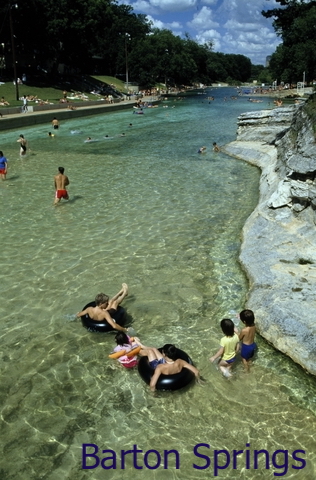
The pool's average temperature is 68°F (20°C), ideal for year-round swimming. Depths of the pool range from 0 to 18ft (0 to 5.4m). Source: Austintexas.org.
The pool is 3 acres, surrounded by grassy areas open for picnicking and relaxing.
Due to the number of visitors and location in a highly-populated area, the pool has had issues with high bacteria content.
Nevertheless, the contamination source has been undetermined. It may be from visitors, or it may be from the spring source close to urbanized areas.
Contamination is worse during heavy rains and hot summer months. Higher temperatures promote bacteria growth!
The pool is closed during flash flood warnings as Barton Creek may flood and overflow the pool. On such occasions, the pool turns into a raging creek.
Fortunately, Zilker park is close to downtown Austin. Hotels.com has different options in the area, but The Carpenter Hotel is within a mile. It has an outdoor pool, a restaurant, a bar, a terrace, and all sorts of amenities for visitors. For rooms available, visit this link!
Krause Springs
Located 30 miles west of the city of Austin, TX. Kraus Springs is a popular swimming and camping site.

The property has 32 springs that feed a man-made pool on top of the hill. This pool, in turn, feeds a natural pool below. The water eventually flows to Lake Travis.
To access the springs, you must descend through a staircase. The natural swimming area has a waterfall and a cave.
The area is surrounded by cypress trees and rocks.
The site is 115 acres of private property under the National Registry of Historic Sites. The property also has a butterfly garden worth visiting.
It is open 10 months of the year, and it is possible to tent and BBQ on site. Source: Krausesprings.net.
Krause is in Hill Country, not far from Lake Travis. Visitors can spend the night at a Tiny House listed on Vrbo, not far from the springs. This home is perfect for relaxing and enjoying the natural surroundings. The area is also known for its vineyards, so you may also visit a winery. For more details, click on this link!
Jacob's Well
Jacob's Well is in Jacob's Well Natural Area, located between the city of Austin and San Antonio. The Natural Area is over 81 Acres.

Jacob's Well is the second-largest completely submerged cave in Texas.
Jumping into the deep hole up from the rocks is a surreal experience.
The cavern system has the main cavern of 4,341ft in (1.3Km) in length and a secondary one of 1,314ft (400m). The deepest part of the cavern system is 140ft (42.6m) deep.
The source of the water comes from Trinity Aquifer. The water temperature is a constant 68°F (20°C).
You must visit between May and September and make a reservation before arriving. Source: Jacob's Well.
Jacob's Well is between two incredible cities. Nevertheless, if you prefer to wake up surrounded by nature, this VRBO rental is for you. The house is within half a mile of the spring and is next to Cypress Creek. For incredible more about this property, click here!
Hancock Springs Pool
This is the oldest spring-fed pool in Texas. The water temperatures are about 68°F (20°C).
The spring feeds Sulphur Creek and eventually the Lampasas river. The pool has a sulfur smell (like rotten eggs). Because of its mineral contents, some people believe it can heal anything.
You may visit this pool between Memorial Day and Labor Day Weekends. No need for reservations.
Spicewood Springs
Located two hours northwest of Austin, in Colorado Bend State Park, west of Lampasas. The park has an area of 5,328.3 acres.
The park is characterized by hills, cliffs, and canyons. The park also has more than 200 caves and a 70ft (21.3m) spring-fed waterfall.
Spicewood Springs is one of the best swimming holes in Hill Country. The springs temperature is 72°F to 76°F (22°C to 24°C).
The largest swimming hole is 9ft (2.7m) deep and is not recommended for young children or poor swimmers. The other pools are shallow and easy for young ones.
To reach the first spring, you have to walk a short flat trail of half a mile. You need to take good shoes to walk the rugged but beautiful terrain, hike all the trails, and check the fantastic views and all the spring-fed swimming holes.
Merrell offers a wide variety of hiking shoes on Amazon. The Moab Vent hiking boot has a rubber sole and breathable mesh lining. It is made of leather and is perfect for this type of terrain.
Besides the springs and Gorman Falls, the park also offers a river full of fish for swimming and kayaking, cave tours, and 35 miles of trails for biking and hiking.
The Springs are open year-round, but it is recommended that you make reservations before you arrive. Colorado Bend.
Comal Springs
Comal Springs is in Landa Park, located in New Braunfels. Comal Springs are the largest in Texas and the American southwest.
Seven major springs and dozens of smaller ones occur over a distance of about 4,300 feet (1.3Km) at the base of steep limestone.
Comal Springs feeds a pool with a constant 72°F (22°C) temperature year-round.
The Edwards Aquifer feeds into a lagoon with a lazy river, climbing, and a slide in Landa Park.
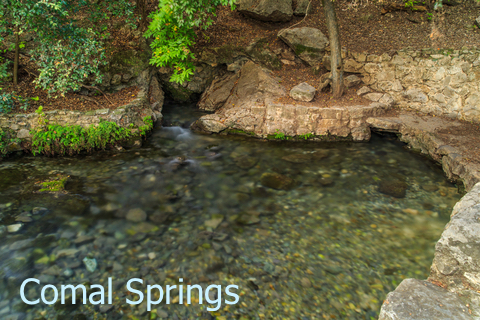
These springs used to be a magnet for Indian Tribes. Many artifacts and burial mounds have been found in the area. Even during colonization, many indigenous people lived in Landa Park.
Attractions include nature trails, paddle boats, a large spring-fed swimming pool, a miniature train, a golf course, and lots of sites for picnicking and relaxation.
Swimming is no longer allowed in a large portion of Landa Lake because it is the habitat of endangered species. Source : Comal Springs.
Chinati Hot Springs
Chinati or Ruidosa Springs is a privately owned oasis. Located in the remote Chihuahua Desert, near the town of Marfa.
The site could be described as a 640-acre resort that is privately owned.
The hot springs are about 113°F (45°C) year-round. Fortunately, there are cool pools nearby if you prefer colder waters.
Besides visiting the springs, it is also possible to go biking and hike on the trails nearby.
Open year-round, reservations are recommended. Houstonia.
Capote Springs
These are a group of springs also located close to Marfa in West Presidio County (West Texas). They are close to Chinati Hot springs.
This is a remote location. You might need directions from locals to find the spring.
The springs have warm mineral water that stays 99°F (37.2°C) throughout the year. This makes it perfect for the winter months.
Near the springs is a 175ft (53m) waterfall called Capote Falls, the largest waterfall in Texas.
The site is home to the endemic spider flower characterized by its multiple stems and only grows in the swamps near the springs. Source: tripping.com
Big Bend National Park Hot Springs
Big Bend National Park Hot Springs used to be in J.O. Langford's stone bathhouse. Today it is possible to enjoy a primitive experience with incredible scenery on the foundation remains of the old bathhouse.
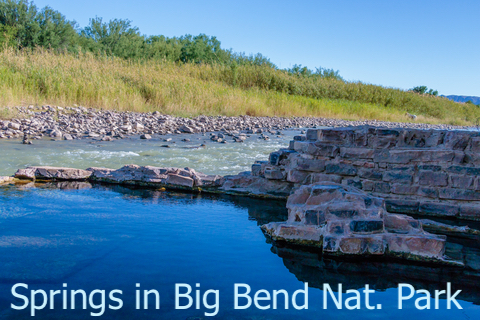
The spring water emerges at 105°F (40°C) with dissolved mineral salts.
It is visited by those seeking its healing and therapeutic values. Some springs may burn because of the temperature or the water chemistry.
Visitors must wait for the river waters to retreat when the Rio Grande floods the springs. Once the river has receded, visitors may also need to clear the vent of debris to enjoy the hot springs and bathe.
Swimming is not recommended since the adjacent river currents are unpredictable.
The springs are not accessible by car. Camping in the area is not possible, but some campsites are nearby.
The hot springs historic district has remains of past dwellers for visitors to see and admire Big Bend.
Blue Hole Regional Park
This beautiful spring is between San Antonio and Austin, in the middle of Texas Hill Country. The park was created by the city of Wimberley to save it from development.
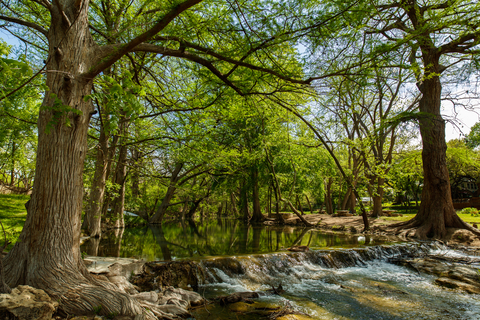
Surrounded by gorgeous cypress trees, this is a natural swimming hole fed by a spring.
The waters of this spring don't disappoint. They are clear with cyan hues. Visitors can play or lay on the grass surrounding the swimming area.
The park also has over 4 miles of trails, picnic areas, an amphitheater, basketball courts, and volleyball courts.
Before you visit, you must make a reservation for the swimming hole. Source: Wimberley.
For more locations to explore in Texas, I suggest you get this book found on Amazon. It is titled Texas Bucket List. This guide includes some springs and other unique landscapes to discover in the Lonestar State!
Texas Springs Threats
Several ailments threaten Texas Springs.
It is estimated that only half of the large springs that once existed in Texas still remain today. If the water table drops, so does the water flow in the springs.
Currently, 60% of Texas residents get municipal water from underground aquifers. Many residential wells are not regulated, and owners pump as much water as they want.
Pumping underground water is a major threat to the existence of springs.
Pollution and recreation are other threats to Springs in Texas. Urbanization brings pollutants to the water that seeps into the aquifers. This water will later come out with more significant amounts of nutrients.
Furthermore, springs belong to different aquifers, which means nearby springs may be subject to different laws.
The latest issue springs face is that some aquifers are in the vicinity of oil wells and fracking. The effects of these activities near the springs are unknown to this day. Source: Austin Chronicle.
Resources for Texas Springs Map
The data points with the locations of Texas Springs were downloaded from USGS.
The Shapefiles with the Texas state boundary were downloaded from the Texas Dept. of Transportation.
The data points with the location of major cities in Texas were downloaded from Texas Cities.
This map will be updated with new data! To receive updates on this and more nature maps, join my email list!!!!!!!
Made by Luz K. Molina with D3.js.

